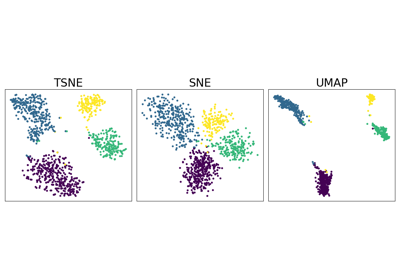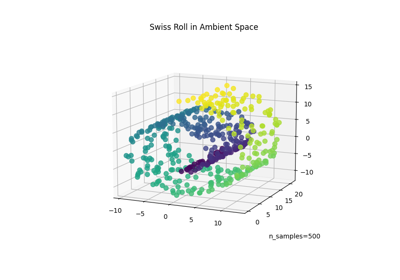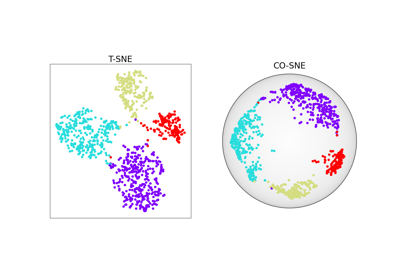SparseNeighborEmbedding#
- class torchdr.SparseNeighborEmbedding(affinity_in: Affinity, affinity_out: Affinity | None = None, kwargs_affinity_out: Dict | None = None, n_components: int = 2, lr: float | str = 1.0, optimizer: str | Type[Optimizer] = 'SGD', optimizer_kwargs: Dict | str = 'auto', scheduler: str | Type[LRScheduler] | None = None, scheduler_kwargs: Dict | None = 'auto', min_grad_norm: float = 1e-07, max_iter: int = 2000, init: str | Tensor | ndarray = 'pca', init_scaling: float = 0.0001, device: str = 'auto', backend: str | None = None, verbose: bool = False, random_state: float | None = None, early_exaggeration_coeff: float = 1.0, early_exaggeration_iter: int | None = None, repulsion_strength: float = 1.0, check_interval: int = 50, compile: bool = False)[source]#
Bases:
NeighborEmbeddingSolves the neighbor embedding problem with a sparse input affinity matrix.
It amounts to solving:
\[\min_{\mathbf{Z}} \: - \lambda \sum_{ij} P_{ij} \log Q_{ij} + \mathcal{L}_{\mathrm{rep}}( \mathbf{Q})\]where \(\mathbf{P}\) is the input affinity matrix, \(\mathbf{Q}\) is the output affinity matrix, \(\mathcal{L}_{\mathrm{rep}}\) is the repulsive term of the loss function, \(\lambda\) is the
early_exaggeration_coeffparameter.Fast attraction. This class should be used when the input affinity matrix is a
SparseAffinityand the output affinity matrix is anUnnormalizedAffinity. In such cases, the attractive term can be computed with linear complexity.- Parameters:
affinity_in (Affinity) – The affinity object for the input space.
affinity_out (Affinity, optional) – The affinity object for the output embedding space. Default is None.
kwargs_affinity_out (dict, optional) – Additional keyword arguments for the affinity_out method.
n_components (int, optional) – Number of dimensions for the embedding. Default is 2.
lr (float or 'auto', optional) – Learning rate for the optimizer. Default is 1e0.
optimizer (str or torch.optim.Optimizer, optional) – Name of an optimizer from torch.optim or an optimizer class. Default is “SGD”. For best results, we recommend using “SGD” with ‘auto’ learning rate.
optimizer_kwargs (dict or 'auto', optional) – Additional keyword arguments for the optimizer. Default is ‘auto’, which sets appropriate momentum values for SGD based on early exaggeration phase.
scheduler (str or torch.optim.lr_scheduler.LRScheduler, optional) – Name of a scheduler from torch.optim.lr_scheduler or a scheduler class. Default is None (no scheduler).
scheduler_kwargs (dict, optional) – Additional keyword arguments for the scheduler. Default is “auto”, which corresponds to a linear decay from the learning rate to 0 for LinearLR.
min_grad_norm (float, optional) – Tolerance for stopping criterion. Default is 1e-7.
max_iter (int, optional) – Maximum number of iterations. Default is 2000.
init (str or torch.Tensor or np.ndarray, optional) – Initialization method for the embedding. Default is “pca”.
init_scaling (float, optional) – Scaling factor for the initial embedding. Default is 1e-4.
device (str, optional) – Device to use for computations. Default is “auto”.
backend ({"keops", "faiss", None}, optional) – Which backend to use for handling sparsity and memory efficiency. Default is None.
verbose (bool, optional) – Verbosity of the optimization process. Default is False.
random_state (float, optional) – Random seed for reproducibility. Default is None.
early_exaggeration_coeff (float, optional) – Coefficient for the attraction term during the early exaggeration phase. Default is 1.0.
early_exaggeration_iter (int, optional) – Number of iterations for early exaggeration. Default is None.
repulsion_strength (float, optional) – Strength of the repulsive term. Default is 1.0.
check_interval (int, optional) – Number of iterations between two checks for convergence. Default is 50.
compile (bool, default=False) – Whether to use torch.compile for faster computation.
Examples using SparseNeighborEmbedding:#

Neighbor Embedding on genomics & equivalent affinity matcher formulation


